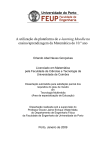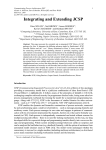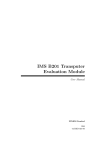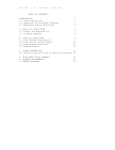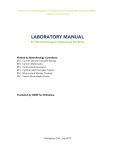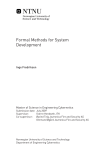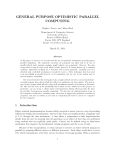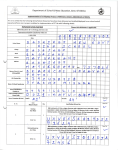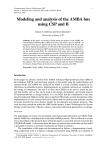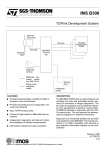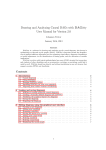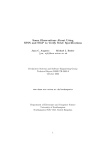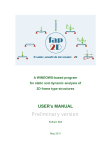Download Becoming textual: attempting to model XCHAN with CSPm
Transcript
Becoming textual: attempting to model ‘XCHAN’ with CSPm
Using FDR2 and ProBE tools when state-ing is not enough
Øyvind Teig, Autronica Fire and Security
http://www.teigfam.net/oyvind/home/
Lecture material at:
http://www.teigfam.net/oyvind/home/technology/063-lecture-ntnu/
1
Exam lecture for
TTK3 - Sanntidsteori, Real-time theory (1)
in the spirit of
TK8112 - The Theory of Concurrency in Real-Time Systems (2)
Trondheim, 15. April 2013 (Electrical Engineering D240 12:15-14:00) ->
(Rev2, after exam same date: typos fixed and new layout on References page)
(Rev3, August 2013: the two pages of «Modeling XCHAN" have been updated)
2
Introduction
1.
2.
3.
4.
5.
Introduction
Theory: XCHAN
Hands on: deadlock
Determinism-analysis of the XCHAN model
Conclusion
3
Meeting the requirements
• What is a requirement and what is an implementation?
• How do we know that an implementation fulfills a requirement?
4
CSPm (also called CSPM)
• CSPm (3),(4) is a scripting language that combines CSP process algebra with an expression language to
support the idioms of CSP
• The three operators ? ! . bind names to values in the functional language part of CSPm. There are no
explicit assignments, but there are «Datatype» definitions
• ? ! are syntactic sugar. «There is no sending, no receiving - just synchronizing on an event and optional
exchange of data.
c?x -> P(x) is syntactic sugar for "will synchronise on any event
c.a ∈ {|c|}, binding the name x to each a in the subsequent process definition"» (in letter from P. A., UofOx)
• Algorithms may be modeled in CSP, not «executed», only shown that they may be executed (the
terms«executable» as used in Promela is not used)
• Not everything in the book (12) (Roscoe) is implemented in CSPm - f.ex. «synchronous parallel». Same
terms may even have different names. See my blog note (5) for a discussion
5
FDR2
• Compiles CSPm scripts. Is Formal System’s «heavy» tool
• I installed it on OSX (Mac OS X) binaries. Again, see my blog note (5)
• Uses X11 (XQuartz on OSX)
• Presently beta testing a new version at University of Oxford (source: UofOx)
6
ProBE
• Also compiles CSPm scripts
• Is «an animator for CSP processes allowing the user to explore the behaviour of models
interactively»
• I discovered that the download link was dead, and when Oxford had been made aware of
this the binaries were restored on 1March2013
• I downloaded the vintage Win95 version, as there was no OSX version. Runs under
WineApp.app on OSX, as does the folding editor WinF. Again, see the blog note (5).
• Proved to be as promising as I had hoped for during my 1-2 moths of FDR-only despair.
Opened up for a lot of aha-experiences
7
Self study
1. After this lecture, you should be able to
2. Install and run FDR2 and ProBE
3. Do self study of mbuff.csp which is covered as a tutorial in the FDR2 User Manual
(6). See «1.4 Specification Example», «1.4.1 Multiplexed buffer example» and «3.2.2
Getting started». I started with this, but will not go throught it here
4. Continue with other files in the ‘demo’ directory. I assume they have been carefully
selected to take the student through most of the secret paths. Many of these have
also been described in the lecture book (12) (Roscoe)
8
Theory: XCHAN
1.
2.
3.
4.
5.
Introduction
Theory: XCHAN
Hands on: deadlock
Determinism-analysis of the XCHAN model
Conclusion
9
XCHAN [1]
x-channel + CHAN
x-channel
CHAN
XCHANs: Notes on a New Channel Type, in Communicating Process Architectures 2012. See (8)
10
Why XCHAN here?
• XCHAN by itself is not relevant to this lecture
• However, going from an English word description
(specification) and trying to model it in CSPm and verifying
the model with FDR2 and ProBE is relevant to this lecture
• XCHAN was «my case» that easily motivated me
• After having learned from my struggling here, try to find your own case
11
Why XCHAN here?
• XCHAN by itself is not relevant to this lecture
• However, going from an English word description
(specification) and trying to model it in CSPm and verifying
the model with FDR2 and ProBE is relevant to this lecture
• XCHAN was «my case» that easily motivated me
• After having learned from my struggling here, try to find your own case
• ..or try to model XCHAN simpler and better (then mail me)
12
XCHAN [2]
Not modeled here
XCHAN
Modeled here
XCHAN
13
XCHAN [2]
Not modeled here
d
n
a
s
u
o
n
o
r
h
s
c
e
i
n
g
y
o
s
l
a
o
f
d
o
o
h
g
t
n
i
e
l
d
m
n
s
a
u
h
o
r
n
o
o
r
F
h
c
n
Modeled here sy
XCHAN
XCHAN
14
Modeling XCHAN
Prof. Peter Welch made several models of buffered and unbuffered XCHAN in occam-pi during proofreading of the original XCHAN paper (*). I have photos of the listings he showed me at CPA-2012 (**), but
here is a summary:
1.
An occam process model of a buffered XCHAN, including a modified standard ring buffer (xchan.occ)
2.
An occam process model of an unbuffered XCHAN. Two versions:
a.
Uses non-implemented !!, !! extended output and input ??, ?? (tho phase write)
b.
Uses two explicit readings on XCHAN end (first to exit ALT, second to pick data)
(*) In my paper I had done reasoning to show
that XCHAN is implementable
(**) The model was presented at the fringe at CPA-2103 (the year after)
An occam Model of XCHANs
Peter H. WELCH (a) and Øyvind TEIG (b)
(a) School of Computing, University of Kent, UK
(b) Autronica Fire and Security AS, Trondheim, Norway
See http://wotug.org/cpa2013/programme.shtml#paper63
15
ASIDE: xchan-ready-first or xchan-ready-classic
• All of Peter Welch’s senders get xchan-ready (true) when the connection with the receiver
was committed. After xchan-ready (true) the sender must send, and this is the only place to
send. This algorithm also fully implements the original XCHAN semantics. We could call this
the «preconfirmed» solution
• The original XCHAN paper may start sending any time, but if sending fails then the xchanready is signalled when the connection with the receiver is fully committed. So, this
«classic» solution only uses xchan-ready to send after an initial failure (*)
(*) At CPA-2013 I published a paper about «feathering», which in fact needs «classic» XCHAN semantics:
Selective choice ‘feathering’ with XCHANs
Communicating Process Architectures 2013 (CPA-2013)
See http://www.teigfam.net/oyvind/pub/pub_details.html#FEATHERING
16
Repeated CSPm back to square one
• I tried to model XCHAN in CSPm as best as I could but for a long time I failed to understand
the landscape:
• ..because I tried to look for Lego bricks that don’t exist
• I continuously had to go back to square one
• Being new to this I even tried to write a «test program» instead of a specification
• A test program that sends data and analyses the output to see if they are correct is not a
specification!
• A specification describes what the implemenation must do in a more general way
It is not a test program!
17
Repeated CSPm back to square one
• I tried to model XCHAN in CSPm as best as I could but for a long time I failed to understand
the landscape:
• ..because I tried to look for Lego bricks that don’t exist
• I continuously had to go back to square one
• Being new to this I even tried to write a «test program» instead of a specification
I
t
a
h
w
y
f
i
c
e
p
s
?
d
e
e
n
• A test program that sends data and analyses the output to see if they are correct is not a
specification!
I
t
’
n
• A specification describes
what
the
implemenation
must
do
in
a
more
general
way
a
c
t
It is not a test
Buprogram!
18
Repeated CSPm back to square one
• I tried to model XCHAN in CSPm as best as I could but for a long time I failed to understand
the landscape:
• ..because I tried to look for Lego bricks that don’t exist
Like
spec
d
l
u
i
f
o
a
y
c
• Being new to this I n
even
tried
to
write
a
«test
program»
instead
of a specification
ing a
d th
n
o
i
t
e sy
a
t
e
c
?
t
fi
s
i
s
t
s
c
e
p
t
e
t
e
r
p
r
m
• A test program that sends data and
analyses
the
output
togsee if they are correct is not a
o
s
e
d
u
r
a
a
n
n
m
e
specification!
u
d
b
e
y
m
r
a
e
t
t
e
m
s
s
t
y
t
?
u
s
B
a
f
• A specification describes
what the implemenation must do in a more general way
o
e
b
It is not a test program!
• I continuously had to go back to square one
19
Problems(?)
1. Writing a specification that as a consequence of a fast producer and slow consumer will sooner or
later lose data
• CSPm has no concept of time, nor any delay. I cannot say something like «during a burst
chan_left must accept one input every tick, but chan_right only accepts one output on every 5th
tick». If so, a buffer of 5 would store for 5-6 ticks without overflow. I don’t know which buttons to
press in CSPm to specify anything like this. And, is there another way to say the same?
• Still I have not resolved what delayed choice and untimed timeout can do for me. They are really
undocumented
• Timed CSP (9) or PAT (11) could perhaps be used for needs like this?
2. Writing a specification that would normally pipe all data through, but may alternatively lose all data
• CSPm has no prioritised choice that would make it possible for me to check chan_ready «first», if
there was nothing there, then chan_left would be included in the choice
3. But will my final result here show that for an XCHAN system I won’t need any of the above?
20
Solutions(?)
I dreamt up more and more difficult solutions. Like
•
trying to simulate prioritised choice (by feedback?)
•
I though I had simulated this in one end of the model, but then, on the other end I failed
•
It became unmanagable for me. That’s when square one was good to have
21
Repeated CSPm but not back to
1?
• Realising what CSPm offers and does not offer is in the learning
• Only recently in this process ProBE appeared, and it made me see and then understand
more
• Learing to reason about a subpart of the system and see that it is enough that this part is
asserted true in a verification, is enough!
• Starting to discover the Lego bricks and their roles: refinement, failures, failure-divergence,
traces, deadlock, livelock and determinism. Hiding (and renaming)
• Starting to see the basics of CSPm slowly takes me by the hand and leads me to a next
level
22
The model(s) architecture
xchan_ready
chan_next
chan_left
P_SERVER
P_CONSUMER
xchan
chan_right
Scheduler
chan_disturb
Figure 1
23
xchan_ready
chan_next
chan_left
P_SERVER
xchan_leg1
P_XCHAN
xchan_leg2
P_CONSUMER
chan_right
chan_disturb
Figure 2
24
xchan_ready
chan_next
chan_left
P_SERVER
xchan_leg1
P_XCHAN
xchan_leg2
P_CONSUMER
chan_right
chan_disturb
Figure 2
25
SYNCHRONISES THE SENDER AND RECEIVER END OF AN XCHANNEL BY EXPOSING THE INNER STATE CHANGES TO THE PARTIES
xchan_ready
chan_next
chan_left
P_SERVER
xchan_leg1
P_XCHAN
xchan_leg2
P_CONSUMER
chan_right
chan_disturb
Figure 2
26
SYNCHRONISES THE SENDER AND RECEIVER END OF AN XCHANNEL BY EXPOSING THE INNER STATE CHANGES TO THE PARTIES
expected value
actual value
xchan_ready
chan_next
chan_left
P_SERVER
xchan_leg1
P_XCHAN
xchan_leg2
P_CONSUMER
chan_right
chan_disturb
Figure 2
27
ALWAYS INPUTS
MESSAGES AND TRIES
TO OUTPUT THEM ON
THE XCHANNEL AND
HANDLES OVERFLOW AT
P_SERVER APPLICATION
LEVEL
xchan_ready
chan_next
chan_left
P_SERVER
xchan_leg1
P_XCHAN
xchan_leg2
P_CONSUMER
chan_right
chan_disturb
Figure 2
28
ALWAYS INPUTS
MESSAGES AND TRIES
TO OUTPUT THEM ON
THE XCHANNEL AND
HANDLES OVERFLOW AT
P_SERVER APPLICATION
LEVEL
xchan_ready
chan_next
chan_left
P_SERVER
xchan_leg1
P_XCHAN
xchan_leg2
P_CONSUMER
chan_right
chan_disturb
Figure 2
29
TAKES INPUT ON
THE XCHANNEL
WHEN IT IS
ALLOWED BY
HANDSHAKE TO
GET RID OF IT
xchan_ready
chan_next
chan_left
P_SERVER
xchan_leg1
P_XCHAN
xchan_leg2
P_CONSUMER
chan_right
chan_disturb
Figure 2
30
EXERCISES THE XCHANNEL AND ALSO CONTAINS THE P_XCHAN HANDLING PROCESS
THE_IMPLEMENTATION
xchan_ready
chan_next
chan_left
P_SERVER
xchan_leg1
P_XCHAN
xchan_leg2
P_CONSUMER
chan_right
chan_disturb
THE_SPECIFICATION
chan_next
chan_left
P_SPECIFICATION_BUFF
P_SPECIFICATION
chan_left
chan_right
chan_disturb
Figure 3
31
IS A COMPOSITE PROCESS OF THE_IMPLEMENTATION AND P_TESTER
THE_IMPLEMENTATION_OUTER
xchan_ready
chan_next
chan_left
P_SERVER
xchan_leg1
P_XCHAN
xchan_leg2
P_CONSUMER
chan_disturb
P_TESTER
chan_main_in
chan_right
chan_main_out
Figure 4
32
THE_IMPLEMENTATION_OUTER
SENDS AND RECEIVES MESSAGES TO/FROM
THE_IMPLEMENTATION AND HIDES MUCH DETAIL
TO SIMPLIFY THE_SPECIFICATION_OUTER
xchan_ready
chan_next
chan_left
P_SERVER
xchan_leg1
P_XCHAN
xchan_leg2
P_CONSUMER
chan_disturb
P_TESTER
chan_main_in
chan_right
chan_main_out
Figure 4
33
THE_IMPLEMENTATION_OUTER
SENDS AND RECEIVES MESSAGES TO/FROM
THE_IMPLEMENTATION AND HIDES MUCH DETAIL
TO SIMPLIFY THE_SPECIFICATION_OUTER
xchan_ready
chan_next
chan_left
P_SERVER
xchan_leg1
P_XCHAN
xchan_leg2
P_CONSUMER
P_TESTER is also called P_TESTER_1
chan_disturb
P_TESTER
chan_main_in
chan_right
chan_main_out
Figure 4
34
THE_IMPLEMENTATION_OUTER
IS A COMPOSITE PROCESS OF
THE_IMPLEMENTATION AND P_TESTER
xchan_ready
chan_next
chan_left
P_SERVER
xchan_leg1
P_XCHAN
xchan_leg2
P_CONSUMER
chan_disturb
P_TESTER
chan_main_in
chan_right
chan_main_out
THE_SPECIFICATION_OUTER
chan_main_in
chan_main_out
Figure 5
35
THE_IMPLEMENTATION_OUTER
xchan_ready
chan_next
chan_left
P_SERVER
xchan_leg1
P_XCHAN
xchan_leg2
P_CONSUMER
chan_disturb
SPECIFIES THE_IMPLEMENTATION_OUTER THAT
FOR EVERY INPUT MAY SEND OUT A TAGGED
P_TESTER
OUTPUT MESSAGE
chan_main_in
chan_right
chan_main_out
THE_SPECIFICATION_OUTER
chan_main_in
chan_main_out
Figure 5
36
THE_IMPLEMENTATION_OUTER
xchan_ready
chan_next
chan_left
P_SERVER
xchan_leg1
P_XCHAN
xchan_leg2
P_CONSUMER
chan_disturb
SPECIFIES THE_IMPLEMENTATION_OUTER THAT
FOR EVERY INPUT MAY SEND OUT A TAGGED
P_TESTER
OUTPUT MESSAGE
chan_main_in
chan_right
chan_main_out
THE_SPECIFICATION_OUTER
What value (if any!) does such a general specification have?
chan_main_in
chan_main_out
Figure 5
37
THE_IMPLEMENTATION_OUTER
xchan_ready
chan_next
chan_left
P_SERVER
xchan_leg1
P_XCHAN
xchan_leg2
P_CONSUMER
chan_disturb
SPECIFIES THE_IMPLEMENTATION_OUTER THAT
FOR EVERY INPUT MAY SEND OUT A TAGGED
P_TESTER
OUTPUT MESSAGE
chan_right
«Different
from LTL assertions, an assertion for refinement
THE_SPECIFICATION_OUTER
compares the whole behaviors of a given process with another
process, e.g., whether there is a subset relationship» (11)
chan_main_in
chan_main_out
chan_main_in
chan_main_out
Figure 5
38
Hands on: deadlock
1.
2.
3.
4.
5.
Introduction
Theory: XCHAN
Hands on: deadlock
Determinism-analysis of the XCHAN model
Conclusion
39
Refusals and acceptances
Refusals
What events a state may not engage in
Acceptances
What events a state must engage in,
if its environment desires
The one is the complement of the other «in ∑»
(6) p38
40
Deadlock: FDR2
occam deadlocked
here because ! has
semantic meaning, in
FDR2 it’s only
syntactic sugar for
any.same_data
without direction!
41
Deadlock: ProBE
P_A = (any.same_data -> any.same_data -> P_A)
P_B = (any.same_data -> any.deadlock_data -> P_B)
42
Deadlock and hiding
Hiding can introduce divergence, and therefore
invalidate many failures/divergences model
specifications
In the stable failures model, a system P can
deadlock if and only if P\ ∑ can. In other words,
we can hide absolutely all events — and move
this hiding as far into the process as possible
using the principles already discussed
(6) p35-36
43
Determinism-analysis of the XCHAN model
1.
2.
3.
4.
5.
Introduction
Theory: XCHAN
Hands on: deadlock
Determinism-analysis of the XCHAN model
Conclusion
44
Simply because
• I struggled more with this than with anything else
45
Pick one and satisfy, but find the right one(s)?
4.3 Choice of Model
The hierarchy of models for CSP are useful because they provide differing amount of
information about the processes, with a corresponding change in the cost of working in
that model. It is more efficient to perform a check in the simplest model which
provides the required detail. (FDR2 (6) manual page 33)
Property
«Simple»
«Complex»
Safety
Model
CSPm
assert # here
[T
4, 10
STOP’ed train = fine!
Traces (refinement)
Do not know what will happen!
STOP refines all!
Liveness
Deadlock-freedom
Determinism
Failures (refinement)
Constrains what it is permitted to
block and perform
[F
5, 11
Livelock-freedom
Liveness properties
Safety also here
Deadlock also here
Determinism also here
Failures-divergence (refinement)
After divergence trace, then livelock
(CHAOS). Detect livelock and used
actively to make events not visible,
hidden
[FD
:[livelock free]
6, 12
2, 8
:[deadlock free]
:[deterministic]
1, 7
3, 9
FDR2 «allows the automatic checking of deadlock and livelock freedom as well as general
safety and liveness properties» (10)
46
In words
Safety [T
• «There should never be a train and a car on the cross point at the same time» (10)
• XCHAN
✓ «A message shall never be lost in XCHAN if there is an available receiver, on a message-permessage basis»
✓ «Over time a fast producer and slow consumer may cause messages to become lost. The XCHAN
sending side (application layer like P_SERVER) is in full control to take whatever action it wants to
ensure that the required safety level is upheld.»
Liveness [F
• «Whenever a car or a train approaches the crossing they should eventually be able to cross» (10)
• XCHAN
✓ «If buffer capacity is reached and no more data arrives all data will eventually be available for a
receiver»
47
The CSPm requirement and
model should then reflect this
• We can’t just write anything and then press any
button to verify that a requested property holds,
like for any other sw program
• I will then have the «determinism property» of the
(good or bad) model I have written verified
assert #6
_OUTER
• However, FDR2 (or I) will pick from its chest of
tools whenever I have written some CSPm and I
press the
button
assert #1
assert #12
• Remember that STOP satisfies any safety
specification (like a trian that stands still) and that
STOP is the simplest deadlocked process
• Therefore we use several properties to tick off as
verified the required properties. This sum of the
results proves the final system
48
Understanding X THE_IMPLEMENTATION_OUTER deterministic[F]
assert
assert
assert
assert
assert
assert
THE_IMPLEMENTATION
THE_IMPLEMENTATION
THE_IMPLEMENTATION
THE_SPECIFICATION
THE_SPECIFICATION
THE_SPECIFICATION
:[deadlock free]
:[livelock free]
:[deterministic]
[T= THE_IMPLEMENTATION
[F= THE_IMPLEMENTATION
[FD= THE_IMPLEMENTATION
assert
assert
assert
assert
assert
assert
THE_IMPLEMENTATION_OUTER :[deadlock free]
THE_IMPLEMENTATION_OUTER :[livelock free]
THE_IMPLEMENTATION_OUTER :[deterministic]
THE_SPECIFICATION_OUTER
[T= THE_IMPLEMENTATION_OUTER
THE_SPECIFICATION_OUTER
[F= THE_IMPLEMENTATION_OUTER
THE_SPECIFICATION_OUTER
[FD= THE_IMPLEMENTATION_OUTER
-------
#01
#02
#03
#04
#05
#06
ok :
ok :
err:
err:
err:
err:
deadlock property [FD]
livelock property
deterministic
[F]
safety property (FDR2 man p33..:)
liveness or deadlock-freedom properties
livelock-freedom property
-------
#07
#08
#09
#10
#11
#12
ok :
ok :
err:
ok :
ok :
ok :
deadlock property [FD]
livelock property
deterministic
[F]
safety property (FDR2 man p33..:)
liveness or deadlock-freedom properties
livelock-freedom property
49
FDR2
«In this case, it is a failure of liveness, which you can tell by the right-hand area having the heading Accepts. Such a behaviour consists of
a perfectly acceptable trace of events performed by THE_IMPLEMENTATION_OUTER and an unacceptably small set of events that
THE_IMPLEMENTATION_OUTER may then offer to its environment.» (FDR2 manual p27 rewritten for this system)
50
ProBE
Observe that the ProBE diagram above jumps right into THE_IMPLEMENTATION and then into P_SERVER, not
THE_IMPLEMENTATION_OUTER
51
ProBE
Level 2
THE_IMPLEMENTATION[|...|]chan_next_!next_out->(chan_left_!xmessage->(chan_right_?piped_through.xmessage->chan_main_out_!piped_through.xmessage>P_TESTER[]chan_right_?newest_after_overflow.xmessage->chan_main_out_!newest_after_overflow.xmessage->P_TESTER))[]chan_left_!xmessage>P_TESTER[]P_TESTER[]chan_disturb_!disturb->P_TESTER\...
Level 3
(P_SERVER[|...|](P_XCHAN[|...|]P_CONSUMER_3(none,1,null))\...)[|...|]chan_left_!xmessage->(chan_right_?piped_through.xmessage->chan_main_out_!
piped_through.xmessage->P_TESTER[]chan_right_?newest_after_overflow.xmessage->chan_main_out_!newest_after_overflow.xmessage->P_TESTER)\...
Level 4
(P_SERVER_5(one,false,false,piped_through,xmessage)[|...|](P_XCHAN[|...|]P_CONSUMER_3(none,1,null))\...)[|...|]chan_right_?piped_through.xmessage>chan_main_out_!piped_through.xmessage->P_TESTER[]chan_right_?newest_after_overflow.xmessage->chan_main_out_!newest_after_overflow.xmessage>P_TESTER\...
Level 5
(P_SERVER_5(one,true,false,piped_through,xmessage)[|...|](xchan_leg2_!commit_discard_xmessage.xmessage->xchan_ready_!ready_send_now->(xchan_leg1_?
piped_through.xmessage->xchan_leg2_!piped_through.xmessage->P_XCHAN[]xchan_leg1_?newest_after_overflow.xmessage->xchan_leg2_!
newest_after_overflow.xmessage->P_XCHAN)[|...|]P_CONSUMER_3(none,1,null))\...)[|...|]chan_right_?piped_through.xmessage->chan_main_out_!
piped_through.xmessage->P_TESTER[]chan_right_?newest_after_overflow.xmessage->chan_main_out_!newest_after_overflow.xmessage->P_TESTER\...
THIS IS level 5:
Level 6
(P_SERVER_5(one,true,false,piped_through,xmessage)[|...|](xchan_ready_!ready_send_now->(xchan_leg1_?piped_through.xmessage->xchan_leg2_!
piped_through.xmessage->P_XCHAN[]xchan_leg1_?newest_after_overflow.xmessage->xchan_leg2_!newest_after_overflow.xmessage->P_XCHAN)
[|...|]P_CONSUMER_3(none,2,xmessage))\...)[|...|]chan_right_?piped_through.xmessage->chan_main_out_!piped_through.xmessage->P_TESTER[]chan_right_?
newest_after_overflow.xmessage->chan_main_out_!newest_after_overflow.xmessage->P_TESTER\...
Level 7
(P_SERVER_5(one,false,true,piped_through,xmessage)[|...|](xchan_leg1_?piped_through.xmessage->xchan_leg2_!piped_through.xmessage>P_XCHAN[]xchan_leg1_?newest_after_overflow.xmessage->xchan_leg2_!newest_after_overflow.xmessage->P_XCHAN[|...|]P_CONSUMER_3(none,2,xmessage))\...)
[|...|]chan_right_?piped_through.xmessage->chan_main_out_!piped_through.xmessage->P_TESTER[]chan_right_?newest_after_overflow.xmessage>chan_main_out_!newest_after_overflow.xmessage->P_TESTER\...
52
ProBE
So, this is not the trace, is it..? But we discuss no-determinisn here..? Hmm.
53
Experimenting with hiding
experiment-1:
removing three hidings will make it deterministic, but fail others!
Search for «experiment-1» in the «2013-03-20-001.csp» file.
It makes both property sets (above and below red line) equal
THE_IMPLEMENTATION = (
...
-- \ {| xchan_ready_, xchan_leg1_, xchan_leg2_ |}
-- experiment-1: to get it deterministic: remove hiding here (1/3)
THE_SPECIFICATION = (
P_SPECIFICATION_BUFF
[| {|chan_mid_|} |]
Generalized parallel /
P_SPECIFICATION)
interface parallel / sharing
-- \ {| chan_mid_ |}
-- experiment-1: to get it deterministic: remove hiding here (2/3)
THE_IMPLEMENTATION_OUTER = (
...
-- \ {| chan_left_, chan_right_, chan_next_, chan_disturb_ |}
-- experiment-1: to get it deterministic: remove hiding here (3/3)
Hiding makes things less obvious and opens for surprises - so
determinism may fail because of this!
54
FDR2 in batch mode. Trail 1
FDR2 batch -trace -depth 5 -refusals /Users/teig/Documents/_Dokumenter/Autronica/NTNU-fag/XCHAN/2013-03-20-001.csp
If -trace has been selected, then report
traces for sub-processes as well as the root
processes. This is the same as expanding
the specified number of levels of the tree in
the FDR debugger, noting down the traces
for each sub-process. The BEGIN TRACE/
END TRACE lines carry additional
information indicating the path through from
the root to the sub-process which generate
the particular trace (6)
A typical use of -depth is when the CSP
script uses hiding and compression and
extracting the full counter-example requires
‘tunneling’ inside those sub-processes. This
is often the case when the CSP has been
automatically generated from some other
notation.
FDR2 produces 6 «trails» for me. I have
named them Trail:1 to Trail: 6. 5-6 not listed
here (space).
(BEGIN batch -depth 5)
Checking THE_IMPLEMENTATION_OUTER :[deterministic]
Starting timer
Starting compilation
Starting...
Compiling...
Reading...
Loading... done
Took 0(0+0) seconds
Starting timer
About to start determinism check
Allocated a total of 2 pages of size 128K
Compaction produced 0 chunks of 16K.
Refinement check:
Trace error after 2 states
Refine checked 2 states
With 1 transitions
Found 1 example
Took 0(0+0) seconds
Refinement check:
Refusal error after 16 states
Refine checked 16 states
With 16 transitions
Allocated a total of 8 pages of size 128K
Compaction produced 0 chunks of 16K.
xfalse
BEGIN BEHAVIOUR example=0 process=0 path=0
BEGIN TRACE (Trail:1)
chan_main_in_.xmessage
_tau
_tau
_tau
_tau
_tau
_tau
_tau
_tau
END TRACE
BEGIN ACCEPTANCES
chan_main_out_.piped_through
END ACCEPTANCES
BEGIN REFUSALS
chan_main_in_
chan_main_out_.newest_after_overflow
END REFUSALS
END BEHAVIOUR example=0 process=0 path=0
BEGIN BEHAVIOUR example=0 process=0 path=0 0
55
Trail 2-4 (5-6 not shown)
BEGIN TRACE (Trail: 2)
chan_main_in_.xmessage
chan_next_.next_out
chan_left_.xmessage
_tau
_tau
_tau
_tau
_tau
chan_right_.piped_through.xmessage
END TRACE
BEGIN ACCEPTANCES
chan_main_out_.piped_through
END ACCEPTANCES
BEGIN REFUSALS
chan_disturb_
chan_left_
chan_main_in_
chan_main_out_.newest_after_overflow
chan_next_
chan_right_.newest_after_overflow
chan_right_.piped_through
END REFUSALS
END BEHAVIOUR example=0 process=0 path=0 0
BEGIN BEHAVIOUR example=0 process=0 path=0 0 0
BEGIN TRACE (Trail: 3)
chan_next_.next_out
chan_left_.xmessage
_tau
_tau
_tau
_tau
_tau
chan_right_.piped_through.xmessage
END TRACE
BEGIN ACCEPTANCES
chan_disturb_
chan_left_
chan_next_
END ACCEPTANCES
BEGIN REFUSALS
chan_right_.newest_after_overflow
chan_right_.piped_through
END REFUSALS
END BEHAVIOUR example=0 process=0 path=0 0 0
BEGIN BEHAVIOUR example=0 process=0 path=0 0 0 0
BEGIN TRACE (Trail: 4)
chan_next_.next_out
chan_left_.xmessage
xchan_ready_.ready_sender_has_xmessage
xchan_leg2_.commit_discard_xmessage.xmessage
xchan_ready_.ready_send_now
xchan_leg1_.piped_through.xmessage
xchan_leg2_.piped_through.xmessage
chan_right_.piped_through.xmessage
END TRACE
BEGIN ACCEPTANCES
chan_disturb_
chan_left_
chan_next_
END ACCEPTANCES
BEGIN REFUSALS
chan_right_.newest_after_overflow
chan_right_.piped_through
xchan_leg1_.newest_after_overflow
xchan_leg1_.piped_through
xchan_leg2_
xchan_ready_
END REFUSALS
END BEHAVIOUR example=0 process=0 path=0 0 0 0
BEGIN BEHAVIOUR example=0 process=0 path=0 0 0 0 0
56
Traces, acceptances and refusals tables
TRACE of THE_IMPLEMENTATION_OUTER :[deterministic]
Trail: 1
chan_main_in_.
xmessage
_tau
_tau
_tau
_tau
_tau
_tau
_tau
_tau
Trail: 2
chan_main_in_.xmessage
chan_next_.next_out
chan_left_.xmessage
_tau
_tau
_tau
_tau
_tau
chan_right_.piped_through.
xmessage
Trail: 3
Trail: 4
chan_next_.next_out
chan_left_.xmessage
_tau
_tau
_tau
_tau
_tau
chan_right_.piped_through.xmessage
Trail: 5
chan_next_.next_out
chan_left_.xmessage
xchan_ready_.ready_sender_has_xmessage
xchan_leg2_.commit_discard_xmessage.xmessage
xchan_ready_.ready_send_now
xchan_leg1_.piped_through.xmessage
xchan_leg2_.piped_through.xmessage
chan_right_.piped_through.xmessage
Trail: 6
chan_next_.next_out
chan_left_.xmessage
xchan_ready_.ready_sender_has_xmessage
xchan_ready_.ready_send_now
xchan_leg1_.piped_through.xmessage
xchan_ready_.ready_sender_has_xmessage
xchan_leg2_.commit_discard_xmessage.xmessage
xchan_ready_.ready_send_now
xchan_leg1_.piped_through.xmessage
xchan_leg2_.piped_through.xmessage
chan_right_.piped_through.xmessage
ACCEPTANCES of THE_IMPLEMENTATION_OUTER :[deterministic]
Trail: 1
Trail: 2
chan_main_out_.piped_through chan_main_out_.piped_through
Trail: 3
chan_disturb_
chan_left_
chan_next_
Trail: 4
chan_disturb_
chan_left_
chan_next_
Trail: 5
Trail: 6
chan_disturb_
chan_left_
chan_next_
xchan_ready_.ready_sender_has_xmessage
REFUSALS of THE_IMPLEMENTATION_OUTER :[deterministic] (There is only external [] choice in use, still we have refusals...?)
Trail: 1
chan_main_in_
chan_main_out_.newest_after_overflow
Trail: 2
Trail: 3
chan_disturb_
chan_left_
chan_main_in_
chan_main_out_.newest_after_overflow
chan_next_
chan_right_.newest_after_overflow
chan_right_.newest_after_overflow
chan_right_.piped_through
chan_right_.piped_through
Trail: 4
chan_right_.newest_after_overflow
chan_right_.piped_through
xchan_leg1_.newest_after_overflow
xchan_leg1_.piped_through
xchan_leg2_
xchan_ready_
Trail: 5
xchan_leg1_.newest_after_overflow
xchan_leg1_.piped_through
Trail:Trail: 6
chan_right_.newest_after_overflow
chan_right_.piped_through
xchan_leg1_.newest_after_overflow
xchan_leg1_.piped_through
xchan_leg2_
xchan_ready_
xchan_ready_.ready_send_now
57
Drawn by hand
Nothing wrong here!
58
THE_IMPLEMENTATION_OUTER
SENDS
AND RECEIVES MESSAGES
TO/FROM THE_IMPLEMENTATION
AND TRIES TO SORT OUT
OVERFLOW OR NOT
xchan_ready
chan_next
chan_left
P_SERVER
xchan_leg1
P_XCHAN
xchan_leg2
P_CONSUMER
chan_disturb
P_TESTER
chan_main_in
chan_right
chan_main_out
Figure 4
At this point this yields the same result as with see of the original P_TESTER
59
Diff’ing logs may be a good idea
60
But traces only differ on _tau and disturb_:
61
• I tried to remove chan_disturb_, but got the exact same result. Then also the _tau were gone, because
chan_disturb_ was hidden in THE_IMPLEMENTATION_OUTER
• Same results with both P_TESTER_1 and P_TESTER_2
• This should indicate that chan_disturb is correctly modeled, since it in fact does not «disturb» at all
62
Finally..
• Removing hiding in THE_IMPLEMENTATION_OUTER
made it deterministic!
• But only with the much more precise P_TESTER_2
which also relates to overflow
• QED?
SENDS AND RECEIVES MESSAGES
TO/FROM THE_IMPLEMENTATION
AND TRIES TO SORT OUT
OVERFLOW OR NOT
63
Conclusion of non-determinism evaluation
• After much effort I finally found a way to see that my implementation is
deterministic!
• From ProBE it also seems to do what I have told it to do
• Even if I know that nondeterminism «comes from» hiding I had to «tune» and go
all the way described in this section
• Observe that I have used
[] (external choice) in all implementations and
|~| (internal or nondeterministic choice) only in the specifications
•
64
CHAOS, WAIT
• Seem to be part of any process set in FDR2.
I don’t know why
• They do not show up in ProBE
• «CHAOS» is a CSPm keyword, it can always
choose to communicate or reject. It is «the
most deterministic divergence-free
process» (7)
•
«WAIT» is not in CSPm. It simply is a delay
operator
• Neither is «RUN» (seen in CSP book (12)). It
is «the process that will deterministically
perform any event» (7)
65
Which tool and when?
• When ok fulfillment of a property:
• observe the assumed behaviour with ProBE
• remove some hiding to watch internal details
• When error:
• use FDR2 and ProBE together
• play around with hiding (and renaming?)
• run FDR2 in batch mode with «depth» parameter
66
Conclusion
1.
2.
3.
4.
5.
Introduction
Theory: XCHAN
Hands on: deadlock
Determinism-analysis of the XCHAN model
Conclusion
67
Conclusions
1. CSPm (as CSP) has a steep learning curve. TK8112 covers the foundations of CSP, but
CSPm seemed to me to be a more different game than I had envisaged
2. How to succeed with FDR2 installation was not so obvious. FDR2 on OSX needed X11
(XQuartz). ProBE runs on WineApp.app on OSX. Wrote blog note, see (5)
3. After having become somewhat familiar with FDR2 and ProBE I encountered to
understand how (or if) I could specify and model XCHAN (8)
4. The present model took me quite far with an «occam in CSPm» approach. I feel
reasonably assured that I have specified and implemented models of the real XCHAN.
But this is in some respects the hardest bit: dragging onself from the marsh to solid
ground
5. Of course I have only scratched the surface of CSP and CSPm
6. It takes time to understand the CSPm landscape, even if CSPm is a language to
formally treat something as «simple» as state machines (or labeled transition diagrams)
68
For NTNU
1. I recommend the next curriculum to include exercises in CSPm. The FDR2 / CSPm User
Manual (6) is packed with a very interesting language! I have shown a flavour of it here.
Because I have (all minus a flavour) left to learn!
2. And also doing exercises in PAT, the Process Analysis Toolkit from the universities in
Singapore and Nanyang (10). Its CSP# language also contains LTL (Linear Temporal Logic)
and works with C# and Microsoft Contracts. Generates code (but not for this example,
since synchronous channels)
3. I also recommend more group work, because it’s hard to drag oneself by the hair
4. I must thank Sverre Hendseth, the lecturer, for his guidance and positive attitude
5. He certainly gave me the impression that there was not much prior work to draw on
concerning CSPm, FDR2 and ProBE at NTNU
69
References
Becoming textual: attempting to model ‘XCHAN’ with CSPm : Using FDR2 and ProBE tools when state-ing is not enough
Øyvind Teig, Autronica Fire and Security : http://www.teigfam.net/oyvind/home/
Lecture material at: http://www.teigfam.net/oyvind/home/technology/063-lecture-ntnu/
(1)
TTK3 - Sanntidsteori (NTNU), http://www.itk.ntnu.no/ansatte/Hendseth_Sverre/sanntidsteori/index.html
(2)
TK8112 - The Theory of Concurrency in Real-Time Systems (NTNU), http://www.ntnu.edu/studies/courses/TK8112
(3)
Formal Systems Europe, http://www.fsel.com
(4)
University of Oxford, http://www.cs.ox.ac.uk/projects/concurrency-tools/ binaries for academic use
(5)
«FDR2 notes», http://www.teigfam.net/oyvind/home/technology/057-fdr2-notes/ by Øyvind Teig.
It also contains some theory clarifications.
(6)
FDR2 User Manual. Download from http://www.cs.ox.ac.uk/projects/concurrency-tools/
(7)
«The Theory and Practice of Concurrency» by A. W. Roscoe. Used during NTNU lectures. Prentice Hall 1998.
See http://www.cs.ox.ac.uk/publications/books/concurrency/. PDF of the book exists on the Internet.
Also see http://www.cs.ox.ac.uk/publications/books/concurrency/
(8)
XCHANs: Notes on a New Channel Type, by Øyvind Teig, in Communicating Process Architectures 2012 (CPA-2012), Proceedings of the 34th
WoTUG Technical Meeting (pages 155-170) P.H. Welch et al. (Eds.) Open Channel Publishing Ltd., 2012 ISBN 978-0-9565409-5-9 © 2012 The
authors and Open Channel Publishing Ltd and the authors.
Read paper and presentation at at http://www.teigfam.net/oyvind/pub/pub_details.html#XCHAN
(8)
"Concurrent and Real-time Systems: the CSP Approach" by Steve Schneider, 1999. It also treats Timed CSP, not supported in FDR2
(9)
«Model checking concurrent RSL with CSPm and FDR2», by Lizeth Tapia and Chris George, May 2008. The United Nations University, UNI-IIST
report No. 393
(10) PAT: Process Analysis Toolkit. An Enhanced Simulator, Model Checker and Refinement Checker for Concurrent and Real-time Systems. This also
takes CSP, but does not seem to be able to directly import CSPm. Made at Singapore University of Technology and Design; School of Computer
Engineering, Nanyang Technological University and School of Computing, National University of Singapore.
Download from http://www.patroot.com.
(11) «The Theory and Practice of Concurrency» by A. W. Roscoe. Used during NTNU lectures. Prentice Hall 1998.
See http://www.cs.ox.ac.uk/publications/books/concurrency/. PDF of the book exists on the Internet.
Also see http://www.cs.ox.ac.uk/publications/books/concurrency/
(12) «The Theory and Practice of Concurrency» by A. W. Roscoe. Used during NTNU lectures. Prentice Hall 1998.
See http:// www.cs.ox.ac.uk/publications/books/concurrency/. PDF of the book exists on the Internet.
Also see http://www.cs.ox.ac.uk/publications/ books/concurrency/
NTNU,15 April 2015
70






































































